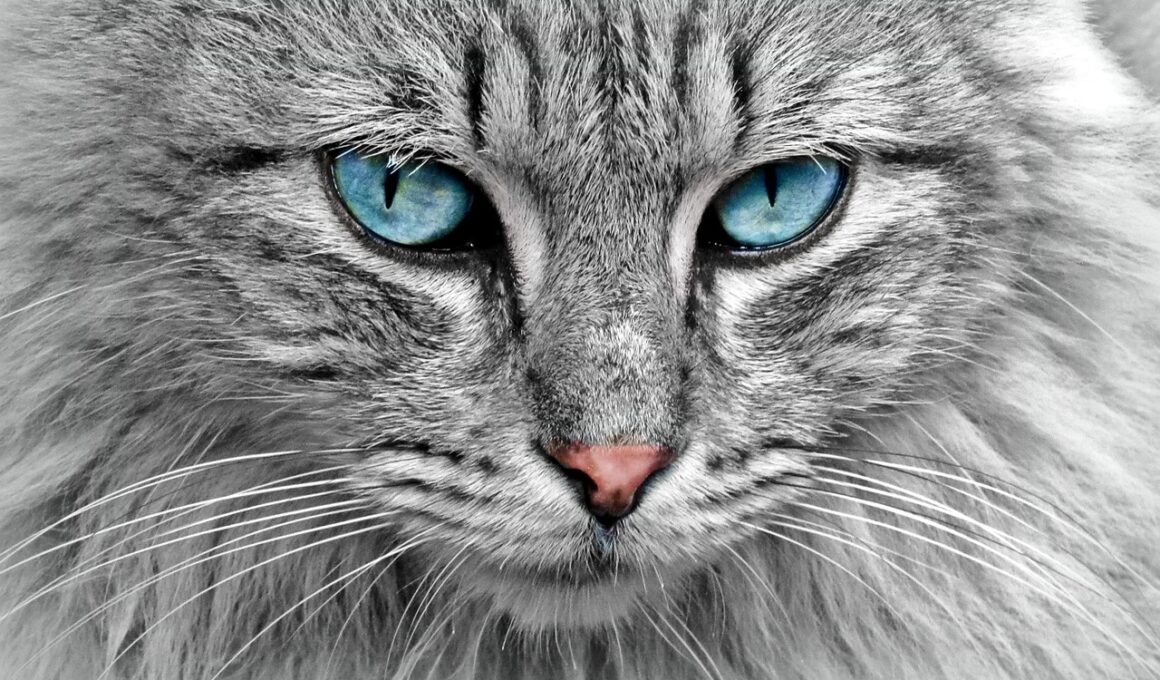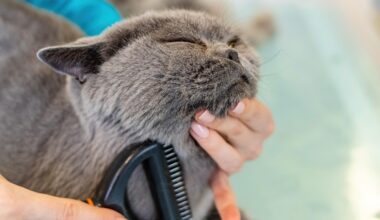Top Tips for Helping Your Cat Become a Friendly Greeter
Welcoming guests with open paws is a skill that can be cultivated in your feline friend. Cats can be naturally wary of strangers, but effective training can help develop their social skills. Start by creating a comfortable environment for your cat to explore when visitors arrive. Keeping a safe space like a cozy bed nearby allows them to observe without pressure. Gradually introduce them to new people by letting guests offer treats. This encourages positive associations with newcomers. Also, consider using soft-spoken voices and gentle movements. Sudden actions may scare or unsettle your cat. Over time, allow your cat to come forward at their own pace. Patience is key in this process; cats typically warm up in their own time. Ensure you reward your cat with treats or praise when they display their friendly behavior. Positive reinforcement can work wonders. Remember, training is an ongoing journey, not a quick fix. Consistency and understanding of your cat’s personality remain critical in adapting their reactions to visitors. Each feline is unique with different comfort levels, so tailor your approach accordingly for the best outcomes.
Establishing a Routine for Socialization
To help your cat feel confident around visitors, creating a predictable routine will do wonders. Socialization opportunities should be regular but non-threatening. Inviting family members over who your cat is familiar with can ease the transition to greeting new guests. Set aside specific times for visitors to drop by and maintain consistency. This allows your cat to acclimate to their presence gradually. It might help to equip your visitors with tasty treats, leading to a positive interaction, which strengthens the bond with your cat. Reward them if they approach your guest or even simply watch from a distance. If your cat shows fear, don’t rush them; allow the cat to retreat if they wish. Utilize toys and engage them prior to your guest’s arrival. A playful demeanor can help alleviate stress. Gradual exposure is critical. Inform your guests to respect your cat’s space; they should avoid direct eye contact or sudden movements. As your cat becomes more comfortable, increase the interaction level. Eventually, your cat will develop the confidence to be a friendly greeter at your open-door policy events consistently.
Understanding how to read your cat’s body language is vital. Cats communicate primarily through their physical state. When training your cat to greet visitors, observe their tail position, ear orientation, and overall body posture. A raised tail indicates confidence, while flattened ears suggest fear or discomfort. If your cat approaches, watch for slow blinks, which signify happiness. Keep an eye out for signs of anxiety, like hiding or avoiding eye contact. Understanding these cues allows you to back off if necessary, reassuring your cat that it’s safe. Redirect their focus through play or offer a secure retreat if they feel overwhelmed. Gradually expose them to different types of visitors, adjusting how you introduce new friends based on your cat’s reactions. Every detail matters—positive associations help establish a welcoming nature over time. Socializing is often done in milestones; don’t rush the process. Each interaction can be used as a learning experience, whether successful or challenging. The primary goal is for your feline friend to feel safe and secure. With patience and understanding, those once-polite greetings can evolve into enthusiastic welcomes!
Creating a Positive Environment
For successful cat socialization, environmental factors are significant. Ensure your home has areas where your cats feel secure. Provide hiding spots such as cat boxes or shelves for elevated comfort. Cats often prefer to observe from above, so having these spaces encourages both exploration and comfort. It’s also essential to maintain a calm environment when guests arrive. Decrease noise levels, and have designated areas for play and interaction without overwhelming your cat. Use calming aids like pheromone diffusers, which can assist in reducing anxiety levels. It’s getting them used to new sights and sounds slowly that breeds confidence. When training, consider inviting only one visitor at a time initially. Invite those who understand cats. Educate your guests on how to treat your cat properly and encourage them to let the cat approach first. Gradual introductions go a long way, allowing your cat to set the pace. Making every interaction a positive experience reinforces their curiosity and friendliness. A relaxed environment is equally crucial for your cat’s comfort during each social visit.
Playtime is an excellent way to foster a friendly disposition in your cat. Engaging your cat in interactive play before guests arrive can stimulate their positive energy. Choosing toys that allow them to pounce, chase, or swat helps reduce pre-visit nervousness. Feathers on a string or laser pointers make for great options. While playing, establish a direct connection, reinforcing their cheerful mood and confidence. Incorporate favorite toys into greetings, engaging them while visitors arrive. This method builds positive associations during encounters. Regular playtime can also be a bonding experience, improving trust. Notably, always follow the play session with praise and treats. After a time of excitement, calming down allows your cat to settle. This creates a well-balanced approach to interactions. Associations of calm and fun can lead to happier visitor greetings. Understand your cat’s unique preferences to guide your approach. Monitor their playfulness levels and adjust accordingly; each cat reacts differently to new stimuli. By creating fun experiences, they will feel more comfortable and excited to greet guests in the future. It’s all about making every moment a cherished experience!
Utilizing Treats and Rewards
Implementing treats and rewards can significantly assist in your cat’s socialization journey. Cats respond positively to rewards, so integrating treats during interactions can help create positive experiences. Train your feline friend to associate guests with good things. Provide treats when guests arrive, creating a scenario where your cat learns to welcome people instead of hiding. Timing is essential here; reward promptly when your cat approaches or engages positively with visitors. Hold the treats away for cats to sniff before offering them, allowing them to associate the guest’s presence with something delectable. As cats become more relaxed, increase the frequency of rewarding them for friendly behavior. Developing consistency in rewarding reinforces desired actions over time. You may consider incorporating clicker training as well, marking these friendly behaviors significantly. Gradually, reduce the reliance on treats by replacing them with praise rather than food. It’s transforming the mindset that guests bring happiness rather than discomfort. Keep in mind that some cats might require longer to adjust. Their journey to being a friendly greeter can be a process filled with love and patience for ultimate success.
As training progresses, consistency is crucial in cementing your cat’s behavior towards visitors. A regular schedule within training, encompassing playtime and treat-giving practices, allows your cat to feel more confident. The more experience they have with newcomers, the more they’ll adapt positively. Make sure every visitor knows the rules: approach slowly and avoid overwhelming your cat. They should understand the cat’s safe space, among other interactions, must not be forced. Acclimation must be gradual; thus, continual assessment of your cat’s comfort is vital. Over time, strive to incorporate larger gatherings as your cat grows more accustomed to social interactions. Establishing rules helps manage the environment, ensuring guests respect boundaries. Ultimately, a friendly cat is created through love, socialization, and understanding. A blend of patience, time, and effort leads to welcoming natures in felines. Even so, every cat is different, so listen to their subtle cues and adjust training as necessary. Your investment in these actively trained behaviors will pay off. Building these habits will allow for enjoyable, stress-free visits for both cats and guests soon!
I hope these strategies help brighten your cat’s confidence. Establishing a friendly greeter in your home requires understanding and dedication. Whether it’s creating a safe environment, adjusting your training routine, or reinforcing positive experiences, each area contributes to the overall outcome. Through commitment, you can effectively transform how your cat interacts with visitors. Gradually easing the way for socialization will yield lovely connections between your feline and guests. Remember that patience is integral in this process; the journey unfolds over time, and every small victory counts. As your cat develops this friendly greeting behavior, you’ll experience much joy in observing the transformation. Engaged cats make the best companions, and their growth will strengthen your bond. Celebrate each milestone with your cat, whether through routine playtime or heartfelt praise. These simple practices lead to creating an inviting atmosphere in your home, treasured for both pet and owner alike. In the end, your love and understanding help cultivate a friendly feline. It’s truly rewarding to see your cat thrive socially, making gatherings far more enjoyable for everyone involved.


